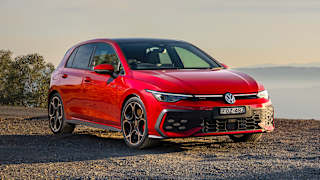The eyebrow-raising factor about Cupra building a mid-size SUV is that it seems to be the antithesis of the brand’s aggressive and sporty philosophy. Sure, it gets away with the Formentor, but only because the crossover proved to be quite distinct from something like its VW T-Roc platform-mate.
Perhaps I shouldn’t have been surprised to find the brand has done it again. As soon as you sit in the Terramar it’s clear this SUV isn’t your average family hauler.
The bucket-style seats immediately hug you, the dash is set nice and low giving you a clear view of the road ahead, and the steering wheel, which the Terramar shares with every other Cupra model, feels suddenly smaller, but just-right under hand.
As soon as you set off, things improve. The 195TSI engine is a belter, and works very nicely with the dual-clutch auto to provide a solid basis for hard acceleration.
While DCT transmissions in the past have been notable for laggy engagement, this latest version (common to other new VW Group products, like the incoming third-generation Tiguan) has been smoothed out, making it feel almost like a traditional automatic from a standstill.
The steering is superb. Not only does the wheel feel ergonomic under hand, but the steering itself is ultra-sharp, making even an SUV this size respond with a feline reactivity.
Wide (255 aspect) tyres reinforce the Terramar’s confidence in the corners, and accelerating out is met by the dual-clutch allowing you to properly ride out the gears, paired with an agreeable engine note.
Standard adaptive dampers feature, giving the Terramar more of a sophisticated feel of the road than many of its platform-mates, although with large wheels and a sportier Cupra-specific damper set, there is a concern that it may ride hard on Australian roads. On the quality European tarmac we tested it on, however, it was comfortable enough.
Sound insulation in the cabin seemed up to the task as well, with the Terramar providing a nice ambiance for countryside driving thanks to low levels of tyre roar and wind noise.
Factors against it? The rear window aperture is a bit small making visibility directly rearward a bit limited, and the lack of physical control dials for core climate and multimedia functions can be distracting when you’re trying to alter them on-the-go.
Other than these small detractors, though, the Terramar is an impressive mid-size SUV. It’s comfortable and quiet, but has attitude in spades and attacks the road with a certain level of confidence well outside the realm of most family haulers in this size-bracket.
It might not be the most affordable option in this category when it arrives, but a keen driver whose budget doesn’t quite stretch to a Porsche Macan will appreciate what the Terramar has to offer.







